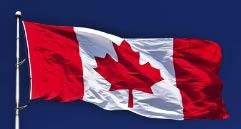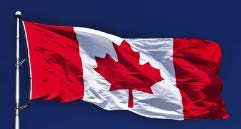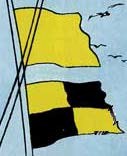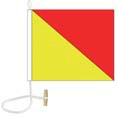2 Supporting Resources – Boater Responsibilities
Course: Basic Navigation & Boat Handling V7 (2024) Book:Supporting Resources – Boater Responsibilities
Printed by: Janet Fraser
Date:Thursday, 1 August 2024, 11:28 PM
Table of contents
Transport Canada Resources Trip Plans
Lifejackets & Personal Flotation Devices Passenger Safety Briefing
Fueling Emergencies Flags
Boating Etiquette
Transport Canada Resources
Pleasure Craft Courtesy Check – Transport Canada has authorized certain organizations to perform Pleasure Craft Courtesy Checks on its behalf. These include:
 The Canadian Coast Guard Auxiliary
The Canadian Coast Guard Auxiliary
 The Canadian Power and Sail Squadrons
The Canadian Power and Sail Squadrons  The Canadian Lifeboat Institution
The Canadian Lifeboat Institution
Trip Plans
Safe Boating Guide Pre-departure Checklist Sailing Plan Templates
CanBoat / NautiSavoir Trip Plan
Lifejackets & Personal Flotation Devices
Personal Flotation Devices
Children’s Life Jackets – Fitting and Securing
Passenger Safety Briefing
How to Safely Fuel a Boat
Further information on managing emergencies can be found in the links below.
Be ready for emergencies. Transport Canada
Common Onboard Emergencies and How To Avoid and Address Them (article)
Vessels wear flags: people fly flags.
Flying flags incorrectly is a sign of the ‘amateur’ seaman.
Although there are many locations to place the various categories of flags you might fly, they follow a logical pattern. Simply stated, the order of precedence follows from the highest organization to which you bear allegiance such as your country (example, Canada), and the precedence moves downward to you as an individual.
On the other hand, ‘points of honour’ relate to the order of importance of the various positions from which you might fly a flag. Obviously, the flag highest in the order of precedence should be flown from the point at which it is awarded the greatest honour. Flags are raised in order of precedence and lowered in reverse order.
The points of honour in descending order are as follows:
 gaff (on a vessel or shore mast equipped with one)
gaff (on a vessel or shore mast equipped with one)  flagstaff at the stern
flagstaff at the stern
 bow staff
bow staff
 starboard spreader (halyard)
starboard spreader (halyard)  truck (top of the mast)
truck (top of the mast)
 port spreader (halyard)
port spreader (halyard)
The highest point of honour on your boat is always reserved for the National Ensign (Canada flag  . Every other flag should be worn at a lower point of honour, even when you are not flying the National Ensign.
. Every other flag should be worn at a lower point of honour, even when you are not flying the National Ensign.
For example, if you are flying only a club burgee, it should never be worn at the point of honour; this is where you would display the National Ensign.
Similarly, an officer’s flag should not be worn at the point of honour from which you would normally display your club’s burgee. So when you are not flying the National Ensign, the point from which it would fly normally must remain bare, even when you are flying other, lesser flags or pennants.
National Flag of Canada
The National Flag of Canada is the proper and preferred flag for all Canadian vessels.

Your boat should wear it from 0800 until sunset or always when under way, day or night, weather and rig permitting.
While in port, if you leave your boat and will not return before sunset, lower the National Flag before you go.
The Canadian flag is raised first and lowered last.
Provincial or other flags are not to be flown in the place of the National Flag.
The National Ensign should be displayed at the peak of the gaff, the outer end of the spar which extends aft from the mast of your boat, if your boat has a gaff. If it does not, fly it from the flagstaff at your boat’s stern. If your boat has an overhanging boom or an outboard motor, your flagstaff may be offset to starboard (preferably) from your boat’s centreline.
CanBoat / NautiSavoir and Other Association Flags
 The preferred location to fly the CanBoat / NautiSavoir flag is the starboard yardarm or spreader halyard. It may be worn day and night.
The preferred location to fly the CanBoat / NautiSavoir flag is the starboard yardarm or spreader halyard. It may be worn day and night.
Pennants and burgees may be worn at a spreader halyard. If your boat has two or more masts, fly your burgee at the truck of the forward mast. If your boat does not have a mast or is a single-masted yacht with a bow staff, fly your pennant or burgee from the bow staff. Boats without a bow staff should wear a burgee at the truck of a single-masted yacht.
Do not display more than one burgee or pennant at a time.
Flags of associations, example, a cruising club such as CanBoat / NautiSavoir, generally may be worn on a spreader halyard. If you have more than one halyard on each side of your boat, fly the superior signal from the outboard starboard halyard and fly other signals to its left, in order of decreasing dignity.
Officer’s Flags
 The officer’s flag, like this Chief Commander flag, is flown at the masthead in place of the club burgee.
The officer’s flag, like this Chief Commander flag, is flown at the masthead in place of the club burgee.
On motor boats without a mast, an officer’s flag may be flown from an antenna, preferably on the starboard side.
International Boating
When you visit foreign waters, your boat should display the flag of the country you are visiting whenever your Canadian flag is displayed.
This flag is called a ‘courtesy flag’. Your courtesy flag may not be larger than the National Flag. If your vessel is mastless, it should wear this courtesy flag at the bow. If your vessel has one or more masts, display this flag single-hoisted at the outboard signal halyard of the main starboard spreader. Do not fly a foreign courtesy flag after you have returned to Canadian waters. It is not to be used as a badge of accomplishment for having cruised to another country.
Other Flags

A quarantine flag must be flown from the starboard halyard or spreader when entering a foreign port until you have been cleared by their customs and immigration department.
 Until that time, only the captain may leave the boat, and only to report the boat’s arrival at the customs office.
Until that time, only the captain may leave the boat, and only to report the boat’s arrival at the customs office.  The crew may only leave the boat to make it fast and then must go back aboard until cleared.
The crew may only leave the boat to make it fast and then must go back aboard until cleared.
 The man / person overboard flag should be fastened permanently to the man overboard pole, which, of course, should be weighted at the bottom.
The man / person overboard flag should be fastened permanently to the man overboard pole, which, of course, should be weighted at the bottom.
 It should be sitting in a pocket at the stern or side of the boat and should be immediately tossed in the water upon discovery of a person overboard.
It should be sitting in a pocket at the stern or side of the boat and should be immediately tossed in the water upon discovery of a person overboard.
 This flag may also have a stiffening rod or wire attached so it is visible, even when there is no wind.
This flag may also have a stiffening rod or wire attached so it is visible, even when there is no wind.
Boating Etiquette
CanBoat / NautiSavoir Boating Etiquette
The Basics of Boating Etiquette: What to Know Before You Set Sail (a brief article)
END OF SUPPORTING RESOURCES – Click here to return to Boater’s Responsibilities
Time left 3:59:25
Question 1Not yet answered Marked out of 4.00
Pleasure Craft have a Canadian Compliance Notice attached to the hull. The Notice provides safety information. Remember, these limits are for good weather only.
From the list below, select the four pieces of information that are contained in a Compliance Notice.
Select one or more:
 Maximum speed of the vessel
Maximum speed of the vessel
 Total weight the vessel can hold (kg./lbs.)
Total weight the vessel can hold (kg./lbs.)  Motor size (kW/HP)
Motor size (kW/HP)
 Maximum wave height
Maximum wave height  Year of construction
Year of construction
 Passenger load limit
Passenger load limit  Weight distribution
Weight distribution
 Manufacturer of the vessel
Manufacturer of the vessel
Question 2Not yet answeredMarked out of 1.00
What should be done prior to departure and include, at a minimum, the location of safety equipment and the actions to be taken by all crew members in the event of an emergency.
Select one:
 An overview of the planned cruise
An overview of the planned cruise  Training on using the marine radio
Training on using the marine radio  A safety briefing
A safety briefing
 Introductions which include information about the skill levels of all onboard
Introductions which include information about the skill levels of all onboard
Question 3Not yet answeredMarked out of 1.00
Most boats are equipped with a vapour detector to detect fuel vapours, What other method can be used to detect gasoline vapour in the bilge?
Select one:
 Sniff with the nose
Sniff with the nose
 Use liquid soap and watch for bubbles
Use liquid soap and watch for bubbles
 Use a flashlight to highlight vapours in the air
Use a flashlight to highlight vapours in the air  See if the engine will start
See if the engine will start
Question 4Not yet answeredMarked out of 1.00
When should a responsible boater file a trip plan? Select one:
 After consulting with the Coast Guard
After consulting with the Coast Guard
 When the planned cruise is overnight or covering a long distance
When the planned cruise is overnight or covering a long distance  After listening to the weather forecast
After listening to the weather forecast
 Before going ashore in a unfamiliar port
Before going ashore in a unfamiliar port
Question 5Not yet answeredMarked out of 5.00
From the following list, which five items are included in the Transport Canada mandatory safety equipment list, and must be carried onboard, be in good working order and be easily accessible at all times?
 A copy of the Safe Boating Guide
A copy of the Safe Boating Guide  Vessel safety equipment
Vessel safety equipment
 Navigation equipment
Navigation equipment
 Visual signals (example: flashlight, emergency flares)
Visual signals (example: flashlight, emergency flares)  Personal lifesaving appliances
Personal lifesaving appliances
 Fire fighting equipment
Fire fighting equipment  Food and water
Food and water
Question 6Not yet answeredMarked out of 1.00
What is the most frequent emergency experienced by boaters? Select one:
 Sinking
Sinking
 Running aground
Running aground
 Colliding with floating debris
Colliding with floating debris  Running out of fuel
Running out of fuel
Question 7Not yet answeredMarked out of 1.00
All onboard safety equipment must be Canadian-approved and clearly marked with the appropriate approval label. Select one:
 True
True  False
False
Question 8Not yet answeredMarked out of 1.00
What should you consider leaving with a responsible person, particularly if your planned cruise is expected to last overnight or longer.
It should include the details search and rescue. might need to find you. It is imperative to keep this document updated and the contact person fully informed if there are changes.
Select one:
 A copy of the vessel’s registration papers
A copy of the vessel’s registration papers  Insurance papers
Insurance papers
 Emergency contact information
Emergency contact information  A trip plan
A trip plan
Question 9Not yet answeredMarked out of 2.00
When underway the operator and crew share many responsibilities. Identify two of the most important navigational responsibilities they share?
 The estimated time of arrival at the intended destination
The estimated time of arrival at the intended destination
 An awareness of the vessel traffic and hazards that may impact the safety of the vessel.
An awareness of the vessel traffic and hazards that may impact the safety of the vessel.  The comfort of the crew and guests
The comfort of the crew and guests
 The location (position) of the vessel on the water
The location (position) of the vessel on the water
Question 10Not yet answeredMarked out of 1.00
How long MUST the bilge blower be run before starting the engine? Select one:
 At least ten minutes
At least ten minutes  At least two minutes
At least two minutes  At least four minutes
At least four minutes  At least six minutes
At least six minutes
Question 11Not yet answeredMarked out of 1.00
A ski boat has maximum seating for four people. With the driver and observer aboard, how many skiiers can be towed?
 One
One  Three
Three  Two
Two  Five
Five
Question 12Not yet answeredMarked out of 1.00
When doesn’t a boat operator have to assist a vessel in distress? Select one:
 If offering asssitance may cause serious danger to the rescue vessel and/or the people onboard it.
If offering asssitance may cause serious danger to the rescue vessel and/or the people onboard it.  If it is after dark.
If it is after dark.
 If it is a Coast Guard has been advised of the distress situation.
If it is a Coast Guard has been advised of the distress situation.  If the distressed boat hasn’t asked for help.
If the distressed boat hasn’t asked for help.
Question 13Not yet answered Marked out of 1.00
If you know your vessel will consume 60 litres of fuel on the outbound and homebound legs of a planned trip, how many liters of extra fuel should be carried to ensure an adequate fuel supply?
Select one:
 30 liters
30 liters
 20 liters
20 liters
 60 liters
60 liters
Question 14Not yet answered Marked out of 1.00
What type of footwear should everyone wear to ensure safety when on a boat? Select one:
 Thongs / flip flops
Thongs / flip flops
 Non-skid, lace-up shoes
Non-skid, lace-up shoes  Thick-soled, leather boots
Thick-soled, leather boots
 No footwear — go barefoot
No footwear — go barefoot
Question 15Not yet answeredMarked out of 1.00
What is the first action to be taken by the operator and crew if faced with a sudden, unexpected storm when on the water? Select one:
 Put the engine into neutral
Put the engine into neutral
 Speed up and find a safe port
Speed up and find a safe port
 If not already on, put on lifejackets.
If not already on, put on lifejackets.
 Call Coast Guard to report your location
Call Coast Guard to report your location
Question 16Not yet answered Marked out of 1.00
When do a boat operator’s responsibilities begin? Select one:
 After leaving a harbour
After leaving a harbour
 When there are guests onboard
When there are guests onboard
 Before the boat gets under way
Before the boat gets under way  After leaving the dock or mooring
After leaving the dock or mooring
Question 17Not yet answeredMarked out of 1.00
When should passengers be told of the location of all safety equipment? Select one:
 When under way, once everything is properly stowed
When under way, once everything is properly stowed  When the equipment is required
When the equipment is required
 When the passengers ask about the equipment
When the passengers ask about the equipment  When the passengers first come aboard
When the passengers first come aboard
Question 18Not yet answeredMarked out of 1.00
When under way, who is responsible for all aspects of the boat? Select one:
 This is not an important consideration
This is not an important consideration  The most experienced person on board
The most experienced person on board  The operator
The operator
 The first mate
The first mate
Question 19Not yet answered Marked out of 1.00
What steps should be taken by the operator and crew before refueling a vessel? Select one or more:
 Switch off all electrical equipment.
Switch off all electrical equipment.  Disembark all crew.
Disembark all crew.
 Tie up the vessel securely and switch off the engine(s).
Tie up the vessel securely and switch off the engine(s).  Close all ports and hatches.
Close all ports and hatches.
